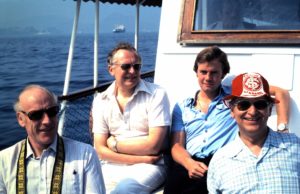POSTED ON OCTOBER 11, 2018
Dr Robert Sykes OBE. Defining the Leather Industry of the 20th century

In 1994 Robert Sykes, who sadly died on the 5th October aged 89, called me and asked if I would be willing to talk to the International Council of Tanners about “Branding Leather” at their annual meeting in Hong Kong. There was no Powerpoint in those days, just an overhead projector with acetates. I only had four with short headings and no text, as I do not like mixing text and talk. The presentation went down very well with the audience. Dr Sykes was ahead of his time and few tanners had thought seriously about branding, which had really only become a “thing” in the late 1989s, but it was probably that event that set the industry on the road to establish Leather Naturally, a body which carries many of the hopes for leather making today.
By 1994 Dr Sykes was late in his career, having retired from his long role as Director of the BLMRA/BLC and staying involved in the industry through the role of Secretary to the ICT. It is hard to think back to the fact that I had first met him when newly into the industry I attended my first IULTCS conference in 1991 in Prague. He and his wife Joan took me in hand and ensured I had useful trip, introducing me to all the key people and ensuring I was never left out.
In 1971 he had just been Director of the BLC, then called the British Leather Manufacturers Research Association (BLMRA), for four years. He had studied in the Leather Department at Leeds University ( with teachers such as McCandlish and Atkin, who had worked with Procter) graduating in 1950 and gaining his PhD there in 1952. He joined the UK Colonial Service and went to East Africa and later joined the Leather Industries Research Industries (LIRI) in South Africa. In 1960 he returned to the UK and took a job in the Applied Science Section of the Leathersellers College in London. Not long after he joined the BLMRA and was appointed Director in 1967.
During his long period in charge he became a dominant presence in the world leather industry during a time of huge transition. The BLMRA was largely funded by a payroll based levy on the UK tanneries so he was always close to the commercial issues facing the industry. I travelled with the British group to an ICT meeting in Buenos Aires some years later where he and Guy Reaks were the only two non industrialist amongst a big group of tanners.
This meant that as you read his many published papers, and activities such as moving the BLMRA to Northampton and overseeing the combination with the Leather Industry Association to create the BLC, his approach was a mix of science and commercial. The research showed the mix of long term and close to market, with an emphasis on the latter because of the heavy industry expectations. He also spoke at length about “defensive” research given that even in a talk in 1972 to the RSA in Bradford he was noting the loss of share of leather in footwear and the need to find new markets.
He was certainly visionary and in that regard one of his most recent acts was to make a very generous donation to the National Leather Collection (formerly the Museum of Leathercraft) in Northampton. I am sure that in the coming weeks and months many finer words will be written about him, but I want to put on record my acknowledgment of the help he gave me throughout my career, be it useful assistance at the start or that ability to engage in considered, thoughtful discussion as the nature, the science and the structure of the leather industry quickly evolved around us.
Mike Redwood
October 2018